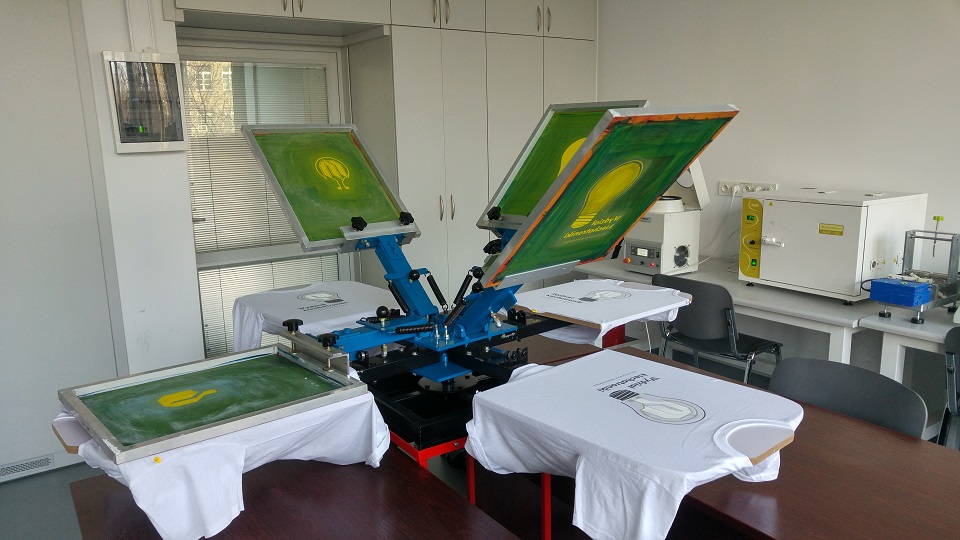Electronics that can be printed on clothing
Business - Innovations – Technology
Good news for all who would love to light themselves up wearing jerseys with lighting elements powered by the electric current (i.e. the electroluminescent or EL technology) and be able to wash and iron the stuff, too. Such clothing has already been created at the Faculty of Mechatronics, Warsaw University of Technology. This is a fancy example of how the technology developed at the Faculty could be applied.
The technology involves the production of a variety of pastes required to print flexible and stretchable electronic layers directly on textiles. Those layers make simple functional (2- or 3-layer) paths or more complex (8- or 9-layer) functional circuits of specific parameters. Sounds good, but what is the practical use in real life? The technology can be applied in apparel printing to integrate electrodes and sensors for non-invasive and real-time vital sign measurement (e.g. your heart beat rate) or EL elements, e.g., to provide visibility to bikers on the road or to make an eye-catchy gadget. “Our imagination and time seem to be the main limit to how this technology can be applied in practical terms,” says Daniel Janczak, Ph.D., the creator of the pastes.
New pastes for textronics
“I have been working on the technology to produce pastes for electronic circuit printing for about 10 years,” says the scientist. “Depending on the paste ingredients, the printed layers are either resistive or conductive or dielectric.
If those layers are printed on a specific surface in an appropriate sequence, a structure can be created that will have certain properties and, thus, be suitable for various uses.”
The researchers of the Faculty of Mechatronics, Microtechnology and Nanotechnology Division led by Prof. Małgorzata Jakubowska, Ph.D., focus on printed electronics. They are successfully printing electronic elements on flexible surfaces such as film, glass or paper. But doing the same on fabrics proved to be a challenge. “The pastes used on typical surfaces do not have the properties allowing them to be applied directly in electronics,” says Janczak. “I have set about developing a family of pastes of varying electrical parameters to enable operable functional circuits to be integrated into a new type of surface – textiles – by various printing technologies.”
A good medium is a key to success
The pastes have two basic components: the functional phase material and the medium. The paste performance is determined by the appropriate selection and combination of the two. Therefore, precision is vital just as much as knowledge and experience.
“Initially, my focus was on a medium that would meet all the requirements that textiles entail: a medium that will be stretch-resistant, washable and iron friendly,” says Janczak. “I invited a group of my students to join me on this project.”
They carried out testing together, including printing proofs on a garment, and then checked those textronic elements for durability and water and heat resistance. Ultimately, it became apparent that one of the media tested did meet all expectations and, with some minor modifications, could be implemented in a variety of pastes.
Those that have been developed so far can already be used to create functional circuits such as electrodes or capacitors. And it is just one step away from jerseys that can collect health information directly from the skin (with appropriate paths transmitting signals to an external device) or that are equipped with an electroluminescent display (here a power supply is needed). “As a process engineer, I cannot imagine anything more challenging than such multiple-layer printing used in this kind of applications,” admits Janczak.
What else can be printed?
But you do not have to go that far to see how useful the newly developed technology can be. “We are more likely to use it to print 2- or 3-layer paths comprising insulation and a conductive layer,” says the scientist. “This way you could, for instance, create a heating path to add warmth to jerseys or gloves.”
Janczak’s plan for the coming future is to develop new pastes and use the medium applied in his pastes to create a transparent electrode. “My other ambition is to speed up the technological process and stop printing directly on textiles but, instead, first print on film or paper and only then transfer it to the target garment.”
Agnieszka Kapela
Promotion and Information Office









